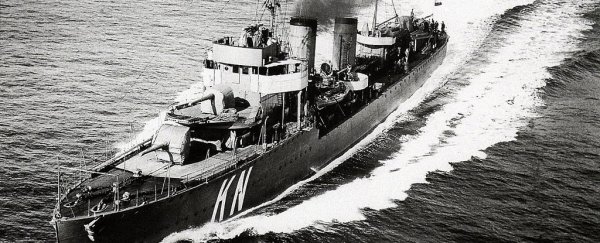The wreckage of six warships and a submarine that have lain on the bottom of the Java Sea since 1942 is now missing, and naval authorities are at a loss to explain the disappearance.
The vessels – including three Dutch ships, six British ships, and a US submarine – all sank during the Battle of the Java Sea in World War II, when allied forces suffered a huge defeat at the hands of the Imperial Japanese Navy off the coast of Indonesia.
The discovery was made during preparations for next year's 75th anniversary of the battle, with the Dutch defence ministry the first to confirm on Tuesday that the wrecks of two of its ships – HNLMS De Ruyter and HNLMS Java – had completely disappeared.
A large piece of a third Dutch ship, HNLMS Kortenaer, has also vanished.
Shortly after, the British ministry of defence confirmed that HMS Exeter and HMS Encounter had disappeared, with much of a third vessel – HMS Electra – gone as well.
A US submarine, the USS Perch, is also missing.
Naval researchers used sonar to create a 3D map of the seabed where the shipwrecks once lay, and while the vessels are no longer there, the indentation they left on the sea floor is still visible.
While the cause of these disappearances hasn't yet been confirmed, naval authorities are launching an international investigation, suspecting scrap metal salvagers are to blame.
It's likely this investigation will involve divers and/or remotely operated underwater vehicles (ROVs) to confirm the sonar readings of the missing vessels, in addition to looking into who might be responsible for the theft.
The seas around Indonesia, Singapore, and Malaysia are thought to contain the wreckage of over a hundred ships sunk during WWII, and the steel, aluminium, and brass that make up these shipwrecks are a lucrative resource for scavengers.
According to a report in the New Straits Times last year, metal scavengers in the region disguise themselves as fishermen and use explosives to blow the shipwrecks apart.
"An investigation has been launched to see what has happened to the wrecks, while the cabinet has been informed," the Dutch defence ministry said in a statement published by The Guardian. "The desecration of a war grave is a serious offence."
The revelations have caused outrage, because the sunken vessels were also the watery graves of hundreds of allied sailors, whose resting places have now been disturbed.
Theo Doorman, the son of Dutch Rear Admiral Karel Doorman, who led allied forces in the battle, told the BBC he could not believe his eyes when he saw the sonar images showing the ships had gone.
"I was sad," he said. "Not angry. That doesn't get you anywhere. But sad. For centuries it was a custom not to disturb sailors' graves. But it did happen here."
While metal scavengers are considered the most likely explanation for how the shipwrecks vanished, not everybody is convinced.
The size of the ships, and the considerable depth at which they lay – some 70 metres (230 feet) underwater – means removing them almost completely like this would have been incredibly difficult.
"It would be almost impossible to salvage this," Paul Koole from Dutch salvage company Mammoet told the Algemeen Dagblad. "It is far too deep."
Indonesian naval representatives agree, saying that removing whole shipwrecks like this would have taken a long time and involved large cranes, meaning the illegal activity would have been noticed.
"To say that the wreckage had gone suddenly, doesn't make sense," Indonesian navy spokesman Colonel Gig Sipasulta told the BBC. "It is underwater activities that can take months, even years."
Here's hoping the new naval investigation can confirm the disappearance with actual sightings to verify that these sunken vessels are indeed missing – in addition to shedding light on some of these ongoing questions.
When we know more about what's happened here, maybe there'll be a chance to help bring those involved in these mysterious disappearances to justice.
Until then, we'll just have to wait and see.
